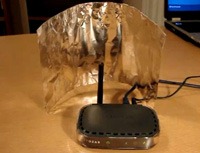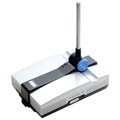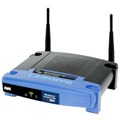Setting up a wireless home network is pretty simple now. Get a wireless router, connect the Internet port of the router to your broadband modem and then connect any of the numbered LAN ports to the desktop computer through an Ethernet cable.
Wireless G (or 802.11g) routers offer fairly good Wi-Fi signal strength but if you plan to transfer large files or stream videos around the house, you may well consider switching to a slightly more expensive Wireless N (or 802.11n) router – these offer better signal strength and higher data transfer speeds than Wireless G routers.
There's however one problem with Wi-Fi signals emanating from your wireless router – they only have a limited range. The wireless signal strength will degrade as the distance between the router and your laptop increases and it will further weaken if you have too many brick walls in the house or if your computer is located on a different floor than the router.
Ways to Boost the WiFi Signal Strength
If you too have a problem getting Wi-Fi signals in every corner of your house, here are some tips (and accessories) to help you extend the range of your wireless network.
#1. Install the DD-WRT* firmware on your wireless router – this might help increase the range of your Wi-Fi router by a few meters if not more.
To increase the signal strength, you can increase the router's transmit power and also disable both frame burst and afterburner (the settings can be accessed from the router's web dashboard). If DD-WRT firmware is not available for your router, try the Tomato firmware on your router.
 #2. Most routers have omni-directional antennas so they emit wireless signals in all directions (just like a light bulb).
#2. Most routers have omni-directional antennas so they emit wireless signals in all directions (just like a light bulb).
That's fine if you have placed the router in a central location but if the router is in some corner of your room or against a wall, consider adding a home-made reflector behind the antennas of your router.
#3. InSSIDer is a free utility that can help you detect the presence and strength of wireless networks. Install InSSIDer on your laptop, walk around the house with your laptop to determine the wireless signal strength at various places and, based on this information, you can quickly find a more suitable location for the router.
** #4.** Ideally, you should place the router at a height in some central location and away from other cordless devices. Make sure that the router is not placed near something metallic (like an almirah or window grills) as that will weaken the wireless signals. Avoid mirrors as they can reflect the wireless signals away from the desired direction.
#4.** Ideally, you should place the router at a height in some central location and away from other cordless devices. Make sure that the router is not placed near something metallic (like an almirah or window grills) as that will weaken the wireless signals. Avoid mirrors as they can reflect the wireless signals away from the desired direction.
#5. Wireless routers generally ship with omni-directional antennas but you can replace them with more powerful uni-directional antennas and that will keep the signal from getting broadcast in all directions.
If you can't find a compatible directional antenna for your router model, consider a booster antenna that's omni-directional but will still boost both the range and strength of wireless signals.
Extend the range of WiFi signals with Hardware
If your router is placed on the ground floor of your home, the Wi-Fi signals will be very weak or may not even reach the basement computer or the printer upstairs. The situation will be no different if you work in a fairly large premises or if there are too many walls in the area.
In that case, here are some hardware device that you can consider to extend the reach of your Wi-Fi network:
 Option #1. You can attach a WiFi Repeater (also known as Wireless Range Expander) to your router and quickly expand the coverage of your wireless network without using any cables.
Option #1. You can attach a WiFi Repeater (also known as Wireless Range Expander) to your router and quickly expand the coverage of your wireless network without using any cables.
The Repeater should be placed within the range of your existing router and it will reflect the signals to other areas where the wireless reception was earlier poor (or totally absent). The Repeater can connect wirelessly to both routers and access points (see #3 below).
Option #2. (This is my current setup) You can get another wireless router and connect it to your existing router using an Ethernet cable. The advantage is that this setup comes pretty cheap and the Internet speed stays almost the same even for computers that are accessing the web via the new router.
You can get a 100 feet long Ethernet Cable (also known as Cat5 or LAN or RJ45 cable) for less than $10 and wireless routers start at $20. Here's a detailed guide on how you can connect two routers together.
 Option #3. You also have the option to use an Access Point instead of a router to extend the WiFi range but that's often not required because Wireless Access Points can be more expensive than equivalent routers.
Option #3. You also have the option to use an Access Point instead of a router to extend the WiFi range but that's often not required because Wireless Access Points can be more expensive than equivalent routers.
The other advantage with a router is that is has extra LAN ports so, in future, you can connect more wired computers for sharing files or you Internet connection.
Option #4. If you have an old desktop or laptop computer, you should consider adding an external (USB based) wireless adapter or upgrade the internal network card to improve the wireless reception (and thus Internet speed).
More tips on Home Networking:
- How to Secure Your Wireless Home Network
- Build a Wireless Home Network without a Router
- Visual Guide to Computer Cables & Connectors
- How to Connect Two Computer Without a Router
Update: Eugene Dimarsky says that option #2 can be amended with a more expensive, but prettier option. Instead of running a cat5 cable, consider a homeplug bridge - also known as powerline network adapters - allowing you to use the power lines in the house to connect the two routers. I've done this about a dozen times in different places and it works very reliably with no cable mess. It does cost an extra $80 or so, but for many it is worth the expense to keep things neat and 'wireless'.





0 Comments